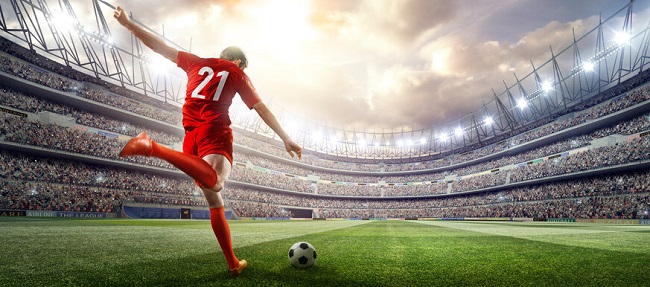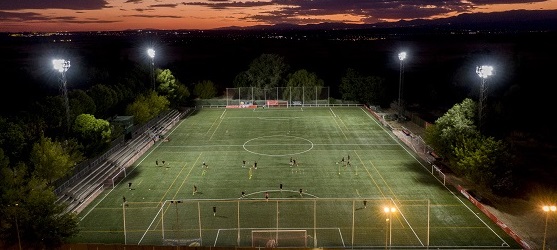Sports have the power to unite individuals from diverse cultures worldwide, and they play a pivotal role in American culture. We can enjoy the outstanding performance from athletes, and feel the electrifying cheers from the crowd. A big part of why we can enjoy thrilling sports events greatly is because of the
stadium lights. Superior lighting provides athletes with the best visibility to perform at their peak and enhances the viewing experience for spectators in the meantime. So, selecting optimal stadium lighting is crucial. We'll walk through the key factors to consider when purchasing stadium lights. Continue reading to gain valuable insights.

- What are Stadium Lights?
Stadium lights are high-powered luminaries designed to illuminate sports arenas and venues effectively. They're set up at tall heights ranging from 40 to over 100 feet with feature small beam angles spanning from 10 to 60 degrees. This specialized lighting is indispensable for both outdoor and indoor sports facilities, ensuring optimal visibility during nighttime events or in low-light conditions. LED sports field lighting offers versatile mounting options tailored to specific spatial requirements, providing easily controllable, dynamic, and energy-efficient solutions. This adaptability allows for the creation of the desired lighting effects within the sports stadium, catering to the unique nature and intensity of each game. This inherent flexibility is an important factor contributing to the widespread popularity of LED sports lights in modern sports stadiums.
- Principle to Follow When Choosing Stadium Lights
Choosing the stadium lights to install depends on several factors. Following these guidelines guarantees better illumination.

-
The dimensions of the pitch determine the needed illumination. In addition to the standard size, some pitches can be slightly smaller or bigger based on how they're used.
-
FIFA determines the lighting arrangement in football stadiums. Commonly, floodlights are installed in a roof rim structure around the pitch, while the lights behind the goal line should be installed at a minimum angle of 60 degrees.
-
The uniformity of light should comply with the standards set by FIFA. This refers to the ratio between the minimum illuminance to the average illuminance on a specified surface. As this value increases, the more uniform the light will be.
-
The position of the lamps and their wattage should be carefully calculated to reduce glare in the pitch.
-
Dimming is an excellent feature to consider whether the pitch is used for a match, training, or maintenance.
-
The LED flicker should be minimized, especially at low light output levels when the light is dimmed.
-
For standard A and B pitches, FIFA requires the color temperature to be between 5000K and 6200K. For standard C and D pitches, the color temperature should be between 4200K and 6200K.
-
The Color Rendering Index should be equivalent to or more than CRI80 in standard A and B pitches and equivalent to or more than CRI70 in standard C and D pitches.
- Factors to Consider While Buying Stadium Lights
For decades, halogen bulbs dominated the arena of stadium lights, but modern LED technologies are currently taking over because they offer several benefits. LED lights meet all the criteria for the ideal stadium lighting solution, making them the top choice in today's market. Check the point we need to take into consideration while selecting the optimal LED stadium lights below:
-
Premium Components: Top-tier components play a pivotal role in guaranteeing the performance, durability, and reliability of LED stadium lighting. Prioritize renowned manufacturers such as Inventronics, Sosen, or UpowerTek, known for their fully isolated LED drivers. Equally crucial are LED modules featuring Seoul, Epistar, Bridgelux, or Lumileds, delivering 145+ lumens per watt. The integration of these superior components ensures LED stadium lights with high light output, extended lifespan, minimal failure rates, and unwavering stability.
-
Weather Resistance: A robust weatherproof design is essential for withstanding adverse weather conditions, including rain, snow, and humidity. In the realm of stadium lighting, achieving a protection rating of
IP65 is considered optimal. In the United States, LED sports field lighting with certification from Underwriters Laboratories (UL) signifies that the lights have undergone rigorous safety testing and meet industry standards.

-
High Color Rendering Index (CRI): A higher color rendering index signifies a truer representation of the object's colors. Optimal CRI, ideally 75 and above, ensures that LED stadium lights can reproduce accurate and vivid colors, akin to natural light. This not only enhances the visibility and clarity for players, referees, spectators, and media personnel but also contributes to an overall superior lighting experience.
-
Light Color Temperature (CCT): CCT serves as a gauge for the warm or cool appearance of light, and selecting the right color temperature is crucial for meeting preferences and specific applications. In the realm of stadium lighting, opting for a color temperature of 5000k is advisable as it mimics natural daylight, creating a dynamic and appealing atmosphere.
-
Glare Mitigation: Glare is defined as unwanted and excessive brightness from LED stadium lights. It will lead to eye strain and discomfort, impacting the vision and performance of players and referees. LED stadium lights equipped with high-end optic lenses and shields can help to minimize glare. Besides, adjusting the angle and intensity of the lights based on the size and shape of the field is also important for optimal performance.
-
Beam angle: A smaller beam angle generates a brighter and more focused light, whereas a larger beam angle has the opposite effect. The optimal beam angle is contingent on factors such as the fixture's height, the field's size, and the desired illumination level. For instance, lower fixture heights may require a larger beam angle to cover a broader area, while higher fixture heights may necessitate a smaller beam angle to mitigate glare and control light dispersion.
- Application of Stadium Lighting
-
Football stadium: Soccer fields are typically situated outdoors, and the lighting needs to be sufficiently robust to ensure ample illumination for nighttime activities. The lighting for football fields should be installed at elevated positions, creating a narrow beam angle to avoid glare and shadows. Besides, it's essential to choose bulbs with waterproof features to withstand adverse weather conditions. For soccer field illumination, bulbs with wattage ranging from 400 to 1500 and lumens between 60,000 to 200,000 are considered suitable.

-
Tennis courts or pickleball courts: Compared to soccer fields, tennis courts and pickleball courts are smaller and more enclosed, requiring lower wattage and higher light focus. Lights should be installed at lower heights with a wider beam angle to cover the entire court. Additionally, bulbs should have a high Color Rendering Index to accurately display the true colors of the balls and the court. The recommended wattage for LED stadium lights on tennis courts and pickleball courts is between 100 to 300 watts, with suggested lumens ranging from 10,000 to 30,000 lumens.
-
Indoor basketball courts: For indoor basketball games, indoor basketball courts require consistent and bright illumination. Lights should be installed at the top to form a wide beam angle, evenly distributing light to avoid glare and shadows. The lighting should also have high CRI and CCT to enhance visibility and clarity for athletes, referees, spectators, and media personnel. The recommended wattage for LED stadium lights in indoor basketball courts is between 100 to 400 watts, with suggested lumens ranging from 10,000 to 40,000 lumens.
These are just some common applications of LED stadium lighting. They can also be used in many other venues, such as golf courses, baseball fields, and football arenas.
- Recommended Stadium Lighting in LEDVANCE
Discover the ideal lighting solution with LEDVANCE's
LED sport lighting.
-
Outstanding Lighting Performance: Leveraging advanced LED technology, our lighting solutions deliver consistent and brilliant illumination throughout the stadium, enhancing the visual experience for both athletes and spectators.
-
Environmentally Friendly Design: Our lamps incorporate energy-saving features, resulting in substantial reductions in energy expenses. This, in turn, effectively lowers the overall operating costs of the stadium, achieving energy savings of up to 64%.
-
Durable and Reliable: Designed for longevity and dependability, our LED stadium lights boast waterproof and dustproof features, ensuring exceptional performance in diverse weather conditions.
-
Expert Team Assistance: Our
dedicated team provides comprehensive pre-sales, sales, and after-sales support. Additionally, you can enjoy a 5-year warranty period to safeguard your investment completely.



